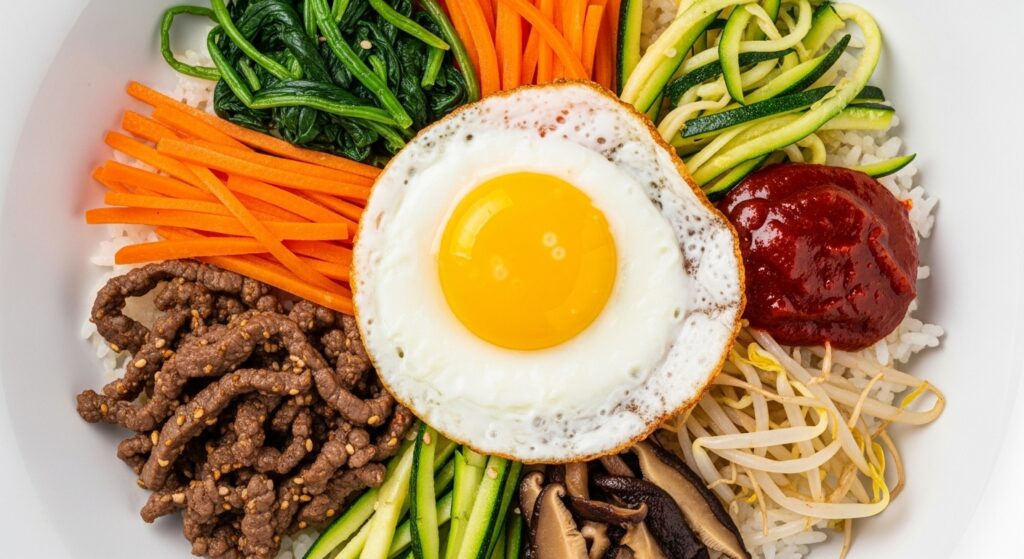A Green Whisper on the Table

Every Korean meal carries a quiet philosophy: harmony, not hierarchy. On a typical table, you’ll see a dozen dishes, each small yet deliberate — spicy kimchi, soft tofu stew, tender meat, and rice that holds them all together. But tucked quietly in the corner sits Sigeumchi-namul, a modest bowl of seasoned spinach that often goes unnoticed until the first bite reveals its calm strength.
There’s no glamour in it, no grand gesture — just blanched greens, sesame oil, garlic, and salt. Yet that simplicity holds the essence of Korean cooking: the belief that food doesn’t need to impress, only to comfort. Like Oi-muchim, another refreshing and minimal Korean side dish, Sigeumchi-namul reminds us that true beauty lies in restraint and sincerity rather than excess.
The Philosophy of Restraint

Korean mothers often teach that food should taste like itself. My mother would always say this while preparing vegetables — her hands moving slowly, her expression peaceful. “Don’t add too much,” she’d whisper. “Just help it be what it already is.” Watching her, I learned that cooking wasn’t about control but respect — the quiet art of knowing when to stop.
That same restraint defines Korean cuisine as a whole. It’s not about transforming ingredients beyond recognition; it’s about letting them speak with honesty. A pinch of salt, a drizzle of oil, a moment of patience — it’s enough. There’s power in not forcing things, in trusting simplicity to do its quiet work.
A Memory of Home

For those who grew up in Korea, the scent of sesame oil instantly feels like home. It’s the smell of morning kitchens, lunchboxes wrapped in cloth, and the echo of chopsticks clinking against ceramic bowls. Even when recreated far from home, Sigeumchi-namul carries that same tenderness — a connection stronger than language, woven through memory and taste.
When I make it now, miles away from the kitchen where I first learned it, the same calm returns. Steam curls from the pot, the spinach turns vivid green, and for a moment, the air feels familiar again. It’s not just cooking; it’s remembering.
The Balance It Brings

Placed beside rich bulgogi or spicy kimchi-jjigae, Sigeumchi-namul restores the meal’s rhythm. It cleanses the palate, cools the spice, and lets the flavors breathe. Without it, the table feels heavy; with it, everything falls back into balance. That’s the hidden beauty of Korean dining — every dish has a role, and harmony always outweighs competition.
Namul dishes like this one show that quietness has its own flavor. It doesn’t demand to be noticed; it simply belongs. In that way, Sigeumchi-namul becomes more than food — it’s the silence that gives meaning to sound, the green pause between stronger tastes.
For a warm and earthy pairing, enjoy it alongside Doenjang-jjigae (Korean Soybean Paste Stew) — together they create the true comfort rhythm of a Korean home meal.
A Lesson in Stillness

Cooking Sigeumchi-namul isn’t a skill test; it’s a meditation. Boil, rinse, squeeze, season — the process is small, but the stillness it offers is vast. The dish asks you to slow down, to watch, to listen. It’s a ritual of care that rewards not perfection, but presence.
When you finally take a bite, the taste is clean, grounded, and deeply human. It doesn’t overwhelm; it soothes. In a world obsessed with more — more flavor, more noise, more speed — Sigeumchi-namul whispers something different: that enough is often everything.
And if you enjoy the refreshing simplicity of this dish, you’ll also love Oi-muchim (Spicy Cucumber Salad) — another side that celebrates the quiet harmony of Korean dining.

Sigeumchi namul (Korean Seasoned Spinach)
Equipment
- 1 Medium pot for blanching spinach
- 1 Strainer for draining blanched spinach
- 1 Mixing bowl for seasoning
- 1 Tongs to mix ingredients gently
Ingredients
- 1 bunch fresh spinach (about 200g) washed and trimmed
- 1 tsp salt for blanching water
- 1 ½ tsp soy sauce for seasoning
- 1 tsp sesame oil toasted
- ½ tsp minced garlic fresh
- ½ tsp roasted sesame seeds for garnish
- 1 pinch salt adjust to taste
Instructions
- Bring a medium pot of water to a boil and add 1 teaspoon of salt.
- Blanch spinach for about 30 seconds, then remove and rinse under cold water.
- Squeeze out excess water gently and transfer to a mixing bowl.
- Add soy sauce, sesame oil, minced garlic, and a pinch of salt.
- Mix lightly with tongs until evenly coated.
- Serve on a small dish and sprinkle sesame seeds on top.


